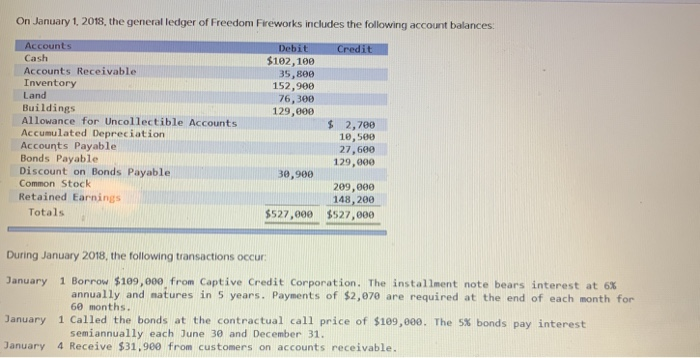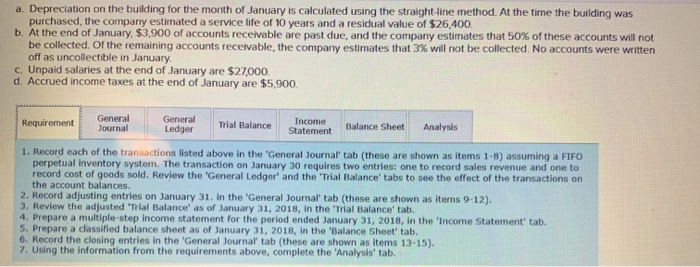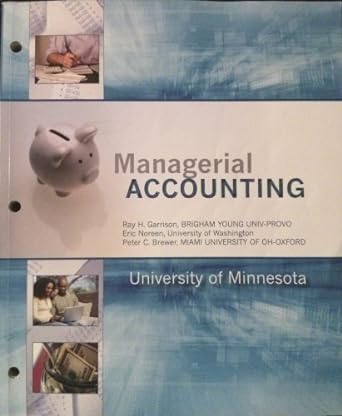On January 1, 2018, the general ledger of Freedom Fireworks includes the following account balances Credit Debit $102,100 35,800 152,900 76,300 129,000 Accounts Cash Accounts Receivable Inventory Land Buildings Allowance for Uncollectible Accounts Accumulated Depreciation Accounts Payable Bonds Payable Discount on Bonds Payable Common Stock Retained Earnings Totals $ 2,709 10,500 27,600 129,000 30,900 209,000 148,200 $527,000 $527,000 During January 2018, the following transactions occur January 1 Borrow $109,000 from Captive Credit Corporation. The installment note bears interest at 6% annually and natures in 5 years. Payments of $2,070 are required at the end of each month for 60 months. January 1 Called the bonds at the contractual call price of $109,880. The 5% bonds pay interest semiannually each June 30 and December 31. January 4 Receive $31,900 from customers on accounts receivable. January 4 Receive $31,900 from customers on accounts receivable. January 10 Pay cash on accounts payable, $20,000. January 15 Pay cash for salaries, $29,880. January 30 Firework sales for the month total $200,400. Sales include $65,999 for cash and $134.500 on account. The cost of the units sold is $117,000. January 31 Pay the first monthly installment of $2,070 related to the $109,000 borrowed on January 1. Round your interest calculation to the nearest dollar. The following information is available on January 31, 2018 a. Depreciation on the building for the month of January is calculated using the straight line method. At the time the building was purchased, the company estimated a service life of 10 years and a residual value of $26.400. b. At the end of January, $3,900 of accounts receivable are past due, and the company estimates that 50% of these accounts will not be collected. Or the remaining accounts receivable, the company estimates that 3% will not be collected. No accounts were written off as uncollectible in January c. Unpaid salaries at the end of January are $27,000 d. Accrued income taxes at the end of January are $5.900 Requirement General Journal General Ledger Trial Balance Income Statement Balance Sheet Analysis 1. Record each of the transactions listed above in the 'General Journal' tab (these are shown as items 1-8) assuming a FIFO perpetual inventory system. The transaction on January 30 requires two entries: one to record sales revenue and one to record cost of goods sold. Review the 'General Ledger and the Trial Balance' tabs to see the effect of the transactions on the account balances. 2. Record adjusting entries on January 31, in the 'General Journal' tab (these are shown as items 9-12). 3. Review the adjusted Trial Balance' as of January 31, 2018, in the Trial Balance' tab. 4. Prepare a multiple-step income statement for the period ended January 31, 2018, in the "Income Statement' tab. 5. Prepare a classified balance sheet as of January 31, 2018, in the Balance Sheet' tab. a. Depreciation on the building for the month of January is calculated using the straight-line method. At the time the building was purchased, the company estimated a service life of 10 years and a residual value of $26.400. b. At the end of January, $3,900 of accounts receivable are past due, and the company estimates that 50% of these accounts will not be collected. Or the remaining accounts receivable, the company estimates that 3% will not be collected. No accounts were written off as uncollectible in January c. Unpaid salaries at the end of January are $27.000 d. Accrued income taxes at the end of January are $5.900 Requirement General Journal General Ledger Trial Balance Income Statement Balance Sheet Analysis 1. Record each of the transactions listed above in the 'General Journal' tab (these are shown as items 1-8) assuming a FIFO perpetual Inventory system. The transaction on January 30 requires two entries: one to record sales revenue and one to record cost of goods sold. Review the 'General Ledger and the Trial Balance' tabs to see the effect of the transactions on the account balances. 2. Record adjusting entries on January 31. in the 'General Journal' tab (these are shown as items 9-12). 3. Review the adjusted "Trial Balance' as of January 31, 2018, in the Trial Balance' tab. 4. Prepare a multiple-step income statement for the period ended January 31, 2018, in the Income Statement' tab. 5. Prepare a classified balance sheet as of January 31, 2018, in the Balance Sheet' tab. 6. Record the closing entries in the 'General Journal' tab these are shown as items 13-15). 7. Using the information from the requirements above, complete the 'Analysis' tab









